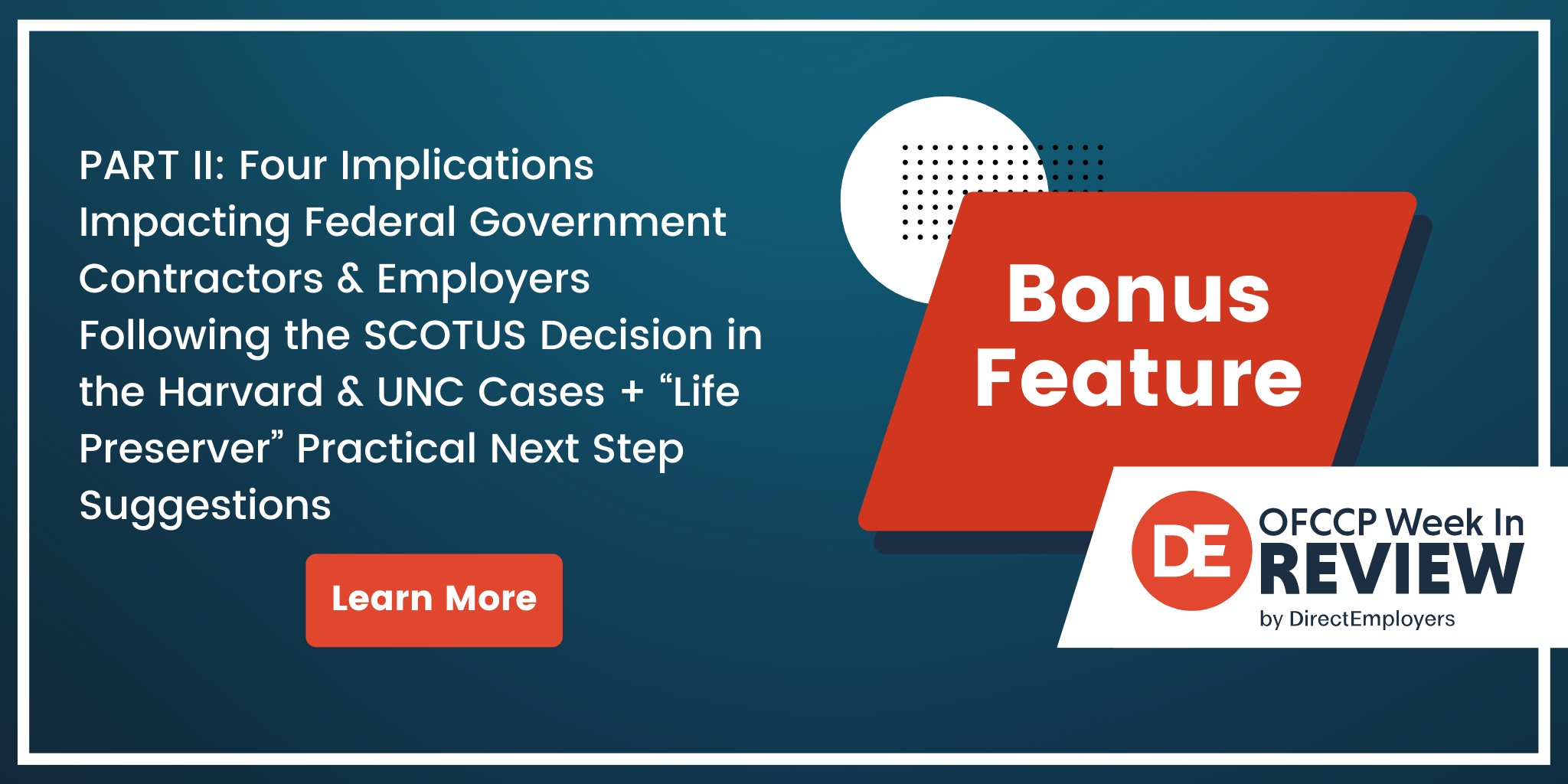
- Part III: Four Implications Impacting Federal Government Contractors & Employers Following the SCOTUS Decision in the Harvard & UNC Cases + “Life Preserver” Practical Next Step Suggestions
- White House Regulatory Affairs Office Issued New Guidance to Agencies on Implementing “Modernizing Regulatory Review” Executive Order
- Republicans Question Whether Julie Su’s Continuing Role at USDOL Renders Her Actions at Labor Illegal (including all Rulemakings)
- USCIS Announced It Will Publish Revised I-9 Form on August 1, 2023
- OSHA Published Final Rule Requiring High-Hazard Industry Employers to Electronically Submit Injury & Illness Records
- U.S. OPM Proposed Allowing Federal Managers To Avoid The Most Qualified Candidates To Pick Those Who Offer Better “Fit”
- How Hiring Works
- Looking Ahead: Upcoming Date Reminders
Part III: Four Implications Impacting Federal Government Contractors & Employers Following the SCOTUS Decision in the Harvard & UNC Cases + “Life Preserver” Practical Next Step Suggestions

If you missed the Harvard/UNC case decision and need a baseline to understand the current state of discrimination law, here is my discussion of the SCOTUS’ decision.
Today’s topic is Doing Right the Right Way: The Renewed Commitment To Hiring African Americans Is Not A “Greenlight” to Unlawfully Discriminate Against Other Protected Groups.
I will describe next week “How to Engage in Race-Based Preferences in employment decisions if that is your choice to do so. But you cannot do “Right” the “wrong way.”
Soon after the murder of George Floyd, I began to receive telephone calls and e-mail inquiries from defense employment law attorneys around the country wondering what I was doing to restrain overzealous corporate clients from unlawfully discriminating against Whites, Asians, and Hispanics in a mad-dash effort to hire African Americans because they were Black. Those contacts continue to this day.
By the time they get to me, the writers and callers had already concluded that their corporate clients had engaged in unlawful hiring discrimination:
“Hire the next five Blacks who apply,” one CEO was reported to have told attendees of his weekly senior staff meeting. “Just hire them.”
“Hire every African American who applies until we employ Blacks about equal to their 11% national workplace population percentage” another caller reported that her client’s HR Manager had ordered the company’s recruiters to do.
One CEO reportedly shouted in exasperation at his senior staff that “We WILL hire an Hispanic to head our South America Group, I don’t care what the lawyers say. What part of “We WILL hire” does anyone here not understand?”
These corporate leaders may think they are doing the “right thing,” but they are doing it the wrong way. These are simply unlawful discriminatory company practices and employment decisions waiting to be found given that these three decisions to hire were “because of” the race or national origin of the Applicant.
Flip the race and National Origin (and gender) around and see how it sounds:
“Hire the next five Whites who apply.”
“Hire every White who applies until we get to their 63% of the workforce percentage.”
“We WILL hire a White (or male) to head our Group in the U.S.”
Hiring Employees “Because Of” Their Race, National Origin or Gender is “Direct Evidence of Discrimination.”
I did not say it is unlawful yet. It is just discriminatory. That leaves room for the employer to go forward with evidence and the burden of persuasion to prove up an “Affirmative Defense” to make its discrimination “lawful.” (That is next week’s Blog discussion as to the circumstances that hiring because of a Protected Status may be lawful). Remember: Discrimination lawyers do not care whether a company discriminated against an Applicant or employee. Rather, concern arises only if the employer’s at-issue employment decision was unlawfully discriminatory.
In legal terms, making a decision to hire based on race or National Origin (or gender) is “direct evidence” of unlawful employment discrimination…ABSENT what lawyers call an…
Wednesday, July 19, 2023: White House Regulatory Affairs Office Issued New Guidance to Agencies on Implementing “Modernizing Regulatory Review” Executive Order
Guidance Emphasized Early Public Engagement & Communications Improvements
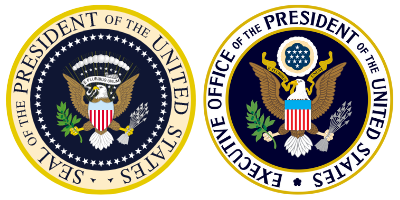
What Are the New Directions?
OIRA’s guidance emphasizes the importance of reaching out to interested members of the public early in the regulatory development process to help build durable, two-way, and trust-based relationships between members of the public and federal agencies. New directions to federal agencies in the guidance include:
- Calling on the agencies to use public engagement – such as working with a local organization to hold listening sessions to hear directly from impacted communities – to help set regulatory priorities, Federal agencies should leverage the biannual Unified Agenda of Regulatory Actions (“Unified Agenda”) OIRA compiles each Fall and Spring to publicize past, ongoing, and future public participation and community engagement activities and to describe how public engagement informed those priorities. (Note: The Unified Agenda is a public document, published twice a year, cataloging regulatory actions underway across the federal government. The timelines the agencies project is almost always too ambitious. Most agencies, particularly the Employment agencies, run months late relative to their longest published date to publication.)
- Encouraging federal agencies to review their communication policies during the regulatory process to facilitate more proactive engagement. OIRA’s concern is that federal agencies be sensitive to and actively reach out to communities that might be affected by a regulation but might not otherwise participate because of barriers such as lack of time, knowledge, accessibility, or trust in government.
- Encouraging federal agencies to adopt leading practices for public participation and community engagement, such as holding regular public listening sessions; using a variety of channels to share information with the public; and building on relationships that local, regional, or district agency offices might have with trusted community intermediaries.
Administrative Procedure Act & Ex Parte Communications
Oral or written communications between agencies and members of the public related to a notice-and-comment Rulemaking process that are not part of a formal written comment are often referred to as ex parte communications. Such communications can benefit members of the public and agencies, including by facilitating more candid discussions and ensuring more opportunities for public input, OIRA Administrator Revesz observed in the memo. However, he cautioned that the agencies must ensure that they properly disclose ex parte communications to avoid creating legal risks to the Rulemaking process.
A federal statute known as the Administrative Procedure Act (“APA”) identifies when federal agencies must engage in Rulemaking. The APA also governs the process for covered federal agencies to engage the public via Public Notices and invitations to Comment in writing on a covered agency’s regulatory proposals. Federal courts have interpreted the APA to require the federal agencies to transparently notify the public when ex parte communications occur, Administrator Revesz explained. Agencies must also treat parties equitably, he added, by making reasonable efforts to afford interested parties an equal opportunity to be heard. (See pages 12-13 of the memo for this discussion.)
Paperwork Reduction Act Concerns
OIRA heard from agencies and members of the public that the Paperwork Reduction Act (“PRA”) “can be perceived as an obstacle to timely engagement in the regulatory process,” Administrator Revesz reported. The PRA requires both that OIRA review certain information collection activities and then require those activities to be available for public comment. The PRA imposes these requirements to ensure the value of the information being collected and to minimize the burden imposed on the public. Revesz addressed these concerns on pages 19-20 of the Guidance Memorandum. First, he “reaffirmed” for agencies that many of the leading practices for engagement described in the memo are exempt from PRA review. “[E]ven when regulatory engagement activities involve PRA review, OIRA already has flexibilities in place that can simplify and expedite the PRA review process,” he explained. Further, “OIRA encourages agencies to consult with their OIRA desk officers to understand the full range of relevant exclusions and flexibilities,” he wrote.
Agencies Will Each Implement Guidance at Their Own Pace
The memo notes (on page 4) that “[a]ppropriate implementation, including the timing and nature of participation and engagement, will differ for each agency and regulatory program. * * * While OIRA is introducing these changes beginning with the 2023 Fall Agenda, OIRA anticipates that agencies may need to apply this guidance at a smaller scale initially, and broaden its application, as practicable and appropriate, to more regulatory activities over time.”
See also, OIRA Associate Administrator Sam Berger’s corresponding blog, “Making Government More Responsive Through Greater Participation in the Regulatory Process.”
Thursday, July 20, 2023: Republicans Question Whether Julie Su’s Continuing Role at USDOL Renders Her Actions at Labor Illegal (including all Rulemakings)
White House Remains Steadfastly Resolved to Support Nomination
Intends to Keep Su Indefinitely in Role of Acting Secretary
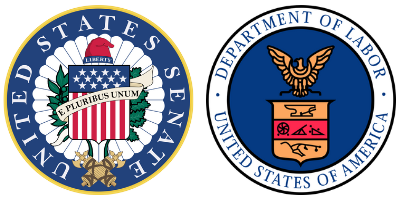
Nevertheless, the White House remained steadfast in its resolve to support the nomination and keep Ms. Su in the role of the Acting Secretary of Labor indefinitely. Ms. Su has been the Acting Secretary of Labor since former Labor Secretary Marty Walsh left the Department of Labor on March 11, 2023. Earlier, she had become the Deputy Secretary of Labor following her Senate confirmation for that role on July 13, 2021.
How Long Can Su Serve as Acting Secretary?
On Thursday, Senate Committee on Health, Education, Labor, and Pensions (“HELP” Committee) Ranking Member Bill Cassidy (R-LA) sent a letter to the President calling on him to withdraw the nomination. Meanwhile, U.S. Senate Republican Leader Mitch McConnell (R-KY) delivered remarks on the Senate floor also critical of Ms. Su continuing in her Acting Secretary of Labor role. In addition, Senator McConnell published a research document cataloging the Republican view of the situation (including a legion of citations to published news reports and legislator’s statements) and accusing the White House of attempting to make an end-run around the Senate by keeping Ms. Su in her capacity as Acting Secretary indefinitely.
Earlier this month, we reported that House Education & Workforce Committee Chair Virginia Foxx (R-NC) sought a formal opinion from the U.S. Government Accountability Office (“GAO”) as to how long Ms. Su may legally serve as the Acting Secretary of Labor. On Thursday, a GAO spokesperson confirmed to Politico that the agency has opened a review but said it has no timeframe for the process.
As we explained in our earlier story, Chair Foxx asked the GAO to look at two competing/conflicting statutes pertaining to how long Ms. Su can serve as Acting Secretary: (1) the Federal Vacancies Reform Act of 1998 (“Vacancies Act”; (5 U.S.C. §3346)), which generally establishes requirements for temporarily filling vacant positions in Executive Branch agencies that require presidential appointment and Senate confirmation, and (2) the statute (29 U.S.C. §552) that created the position of Deputy Secretary of Labor (“Deputy SOL statute.”)
Important to this situation is the Vacancies Act provision stating that “[i]f the nomination is rejected or returned by the Senate or withdrawn by the President, an acting officer may serve for no longer than 210 days after the date of the rejection, return, or withdrawal.” (5 U.S.C. § 3346(b).) Moreover, the Vacancies Act states that if an individual who is neither the agency head nor acting in accordance with the Act performs such functions or duties, those actions have no force and effect and may not be ratified. (5 U.S.C. § 3348(d).)
However, the Deputy SOL statute provides that “[t]he Deputy Secretary shall [] in case of the death, resignation, or removal from office of the Secretary, perform the duties of the Secretary until a successor is appointed ….”
On March 21, 2023, the Labor Department transmitted a submission to the GAO stating that Ms. Su is serving as Acting Secretary of Labor, not under the Vacancies Act, but under the Deputy SOL statute, Representative Cassidy stated in his letter, citing a June 2, 2023 article from Law360 (subscription required).
“It is my view that this use of [the Deputy DOL statute] violates the constitutional provision of advice and consent and would potentially open any DOL action under Julie Su’s leadership to legal challenges,” Representative Cassidy wrote.
White House Remained Steadfast in its Resolve to Support Nomination
In a press briefing on Monday, July 17, White House Press Secretary Karine Jean-Pierre confirmed that the White House continues to have an “unwavering commitment” to support the nomination and will “continue to fight hard.” (See the video here.)
At Tuesday’s press briefing, a reporter asked Press Secretary Jean-Pierre “[w]hat precedent does it set to have [an acting] official doing the job of a Cabinet secretary, when she can’t get confirmed or have the votes to do it?” Jean-Pierre responded that she could not speak to the precedent question, but, yet again, reiterated the Administration’s continued support for the nomination. The Press Secretary also stated that the applicable law allows Ms. Su to continue to serve without any time limit. (See the video here.)
Biden Administration Intends to Keep Su in Role of Acting Secretary Indefinitely
On Thursday and Friday, the White House confirmed to multiple news agencies (including Politico, NBC News, and Reuters) that the Biden Administration believes the Deputy SOL statute is the controlling law in this situation. Accordingly, the Administration maintains that Ms. Su is not subject to the time limits of the Vacancies Act, and therefore, she can serve as Acting Secretary indefinitely.
USDOL stakeholders who feel injured by actions Ms. Su takes, including all USDOL Rulemakings, which they think may be illegal because violative of the Federal Vacancies Act, will need to consult legal counsel as to whether to disobey the offending USDOL action or purported “requirement.” It very much appears that the current stand-off between Republicans and those Democrats who oppose Julie Su’s confirmation as the next Secretary of Labor are now at long term odds with The White House. Indeed, it appears that this matter will not be resolved until after the 2024 Presidential Election and the next President and Senate are seated in early January 2025.
For more background, see our most recent previous story on this continuing saga in last week’s WIR here.
Friday, July 21, 2023: USCIS Announced It Will Publish Revised I-9 Form on August 1, 2023
Employers Must Start Using Revised Form by November 1, 2023
DHS Also Announced New Remote “Flexibility” Procedures For E-Verify Users

What Are the Revisions?
The revised Form I-9:
- Reduces Sections 1 and 2 to a single-sided sheet;
- Is designed to be a fillable form on tablets and mobile devices;
- Moves the Section 1 Preparer/Translator Certification area to a separate, standalone supplement that employers may provide to employees when necessary;
- Moves Section 3, Reverification and Rehire, to a standalone supplement that employers can print if or when rehire occurs or reverification is required;
- Revises the Lists of Acceptable Documents page to include some acceptable receipts as well as guidance and links to information on automatic extensions of employment authorization documentation;
- Reduces Form instructions from 15 pages to 8 pages; and
- Includes a checkbox allowing employers to indicate they examined Form I-9 documentation remotely under a DHS-authorized alternative procedure rather than via physical examination.
Alternative Examination Procedures
Also on Friday, July 21, the DHS announced a Final Rule it will publish in the Federal Register on Tuesday, July 25 here. That Final Rule will recognize the end of temporary COVID-19 “flexibilities” as of July 31 (see our story here). That same Final Rule, however, will provide DHS the authority to authorize optional alternatives for employers to examine Form I-9 documentation. The Final Rule will become legally effective on August 1, 2023.
At the same time, DHS will also publish an accompanying document in the Federal Register describing and authorizing employers enrolled in E-Verify the option to remotely examine their employees’ identity and employment authorization documents under a DHS-authorized alternative procedure. The Federal Register document provides an alternative for certain employers to remotely examine Form I-9 documents, instead of the current requirement to examine documents in-person. To participate in the remote examination of Form I-9 documents under the DHS-authorized alternative procedure, employers must be enrolled in E-Verify, examine and retain copies of all documents, conduct a live video interaction with the employee, and create an E-Verify case if the employee is a new hire.
Employers that were participating in E-Verify and created a case for employees whose documents were examined during the COVID-19 flexibilities (March 20, 2020, to July 31, 2023), may choose to use the new alternative procedure starting on August 1, 2023, to satisfy the physical document examination requirement by August 30, 2023. Employers not enrolled in E-Verify during the COVID-19 “flexibilities” will be required to complete an in-person physical examination by August 30, 2023.
For more background, also see our related, earlier story here.
Friday, July 21, 2023: OSHA Published Final Rule Requiring High-Hazard Industry Employers to Electronically Submit Injury & Illness Records
OSHA Will Also “Out” Industry Safety Data by Publishing Them on OSHA’s Website
Rule Takes Effect January 1, 2024, for Covered Employers
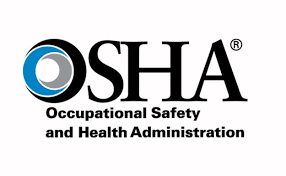
You need to start thinking NOW about what Human Resources data you still currently maintain in only paper or electronic format and which could be converted in the future to digital storage and retrieval systems. Don’t forget about the increasingly arduous task to integrate your data retrieval, storage and access plan with your data privacy and security colleagues and their byzantine rules and requirements. Get your catalog of document systems to transition, get your transition plan and then get a budget and timeline to transition. (And don’t forget to quality control check to confirm that your new digital systems are loading and storing data and documents, and data users are accessing the systems, as you had hoped and planned. There are training and quality control check costs in your transition budget, right?)
Now, here is today’s story:
The U.S. Department of Labor published a Final Rule that will require certain employers in designated high-hazard industries to submit injury and illness information – that they are already required to keep – in electronic format to the Department’s Occupational Safety and Health Administration (“OSHA”). This Final Rule is similar to one the Obama Administration sought but which the then incoming Trump Administration largely rolled back before it could take legal effect. (Details on that history are included in the Final Rule’s preamble here.) This new Final Rule takes effect on Monday, January 1, 2024.
The Final Rule retained the current requirements for submission of information in electronic format for OSHA Form 300A from establishments with 20-249 employees in certain high-hazard industries and from establishments with 250 or more employees in industries that must routinely keep OSHA injury and illness records. The new Final Rule added the following submission requirements:
- Establishments with 100 or more employees in certain high-hazard industries must electronically submit information from their Form 300-Log of Work-Related Injuries and Illnesses, and Form 301-Injury and Illness Incident Report to OSHA once a year. These submissions are in addition to the submission of Form 300A-Summary of Work-Related Injuries and Illnesses. (Those forms are available here.)
- To improve data quality, establishments are required to include their legal company name when making electronic submissions to OSHA from their injury and illness records.
More information on the specific regulations and forms involved is available in the preamble to the Final Rule here. The full Federal Register notice of the Final Rule runs 96 pages.
“OSHA will use these data to intervene through strategic outreach and enforcement to reduce worker injuries and illnesses in high-hazard industries,” asserted Assistant Secretary for Occupational Safety and Health Doug Parker via an agency statement OSHA released on Monday, July 17.
OSHA Will Publish Some of the Data it Collects
The agency statement also noted that:
“OSHA will publish some of the data collected on its website to allow employers, employees, potential employees, employee representatives, current and potential customers, researchers, and the general public to use information about a company’s workplace safety and health record to make informed decisions. OSHA believes that providing public access to the data will ultimately reduce occupational injuries and illnesses.”
“The safety and health community will benefit from the insights this information will provide at the industry level, while workers and employers will be able to make more informed decisions about their workplace’s safety and health,” said Assistant Secretary Parker.
Friday, July 21, 2023: U.S. OPM Proposed Allowing Federal Managers To Avoid The Most Qualified Candidates To Pick Those Who Offer Better “Fit”
OPM Also Now Endorsing Subjective Decision-Making To Supplant Objective Assessments
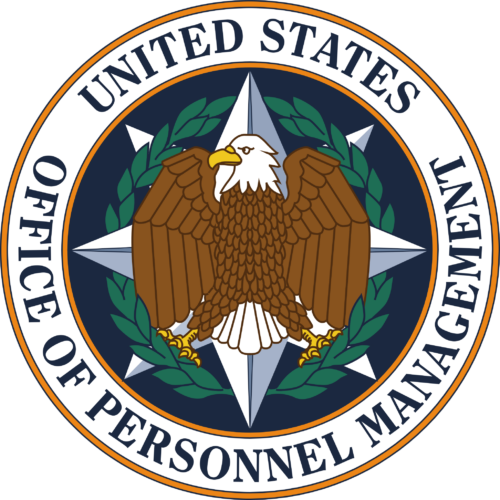
OPM contends the changes in the 10-page proposal would preserve “merit-based hiring,” just not requiring agencies to hire from the “best qualified” candidates available to the hiring manager. The proposed Rule does not apply to or affect existing veterans’ preference hiring Rules. The new process would give federal agency hiring managers access to a larger pool of qualified candidates, OPM stated. Federal agencies would still grant veterans preference points and veterans would continue to be entitled to selection preference over a non-veteran candidate with the same or lower score.
Comments on the proposal are due by Tuesday, September 19, 2023, and may be submitted here.
If you are a glutton for punishment, please also read Cyndi Hackerott’s side-bar story explaining the byzantine processes of the federal government to hire employees into its over 2 million strong civilian workforce. Cyndi’s sidebar story also explains the effect OPM’s proposed changes would have on the federal government’s existing set of hiring processes for its civilian employees.
Friday, July 21, 2023: How Hiring Works

- the Competitive Service,
- the Excepted Service, and
- the Senior Executive Service.
Different laws and regulations govern each class of service (and its particular employment system(s)).
The Competitive Service consists of all civil service positions in the Executive Branch of the federal Government with some exceptions. Four categories of appointments comprise the Competitive Service:
- those subject to delegated examining procedures (meaning that, the agency may decide how to hire its employees, whether by test, interview, demonstration of performance, or all of the above);
- those filled through promotion and internal placement (i.e., merit promotion) procedures;
- those filled on a non-competitive basis; and
- those filled under direct hire authority.
The proposed regulations OPM published on Friday impact positions filled in the Competitive Service using “delegated examining procedures” (i.e., the first category). These proposed changes would also affect how agencies select candidates for “Excepted Service” appointments (i.e., political appointees, et al).
The Director of OPM has delegated to agency heads the authority the President had originally delegated to the OPM Director to conduct competitive examinations for positions in the Competitive Service. Agencies with such “delegated examining authority” may fill competitive civil service jobs with:
- applicants from outside the federal workforce;
- federal employees who do not have competitive service status (i.e., temporary or limited term employees, and individuals who hold or held an excepted service position which did not provide for conversion to the competitive service); or
- federal employees with competitive service status ( i.e., career or career-conditional employees).
Agencies use “delegated examining” (also called “competitive examining”) procedures to fill positions in the competitive service for which any U.S. citizen may apply. “Competitive examining” supports federal merit system principles by promoting recruitment from all segments of society, fair and open competition among job-seekers, and selection based on an applicant’s competencies or knowledge, skills, and abilities, OPM explained in the preamble to the Proposed Rule. OPM maintains oversight of its delegated examining authority to ensure agencies apply their delegated authority in accordance with the merit system principles set out in 5 U.S.C. §2301.
There are three stages to the competitive service federal hiring process:
- the assessment process ( i.e., the rating and ranking of applicants and application of veterans’ preference);
- the certification process ( i.e., the process through which applicants are listed on a certificate of eligible candidates (“Certificate of Eligibles”) in the order of their assessed scores, adjusted for veterans’ preference); and
- the selection process ( i.e., the process for choosing among applicants based on their numerical rankings in accordance with veterans’ preference requirements).
The “Rule of Three” (requiring the hiring from among the best-qualified candidates)
Traditionally, when a federal agency hires for a position in the “Competitive Service,” the agency applies during its final selection process what is known as the “Rule of Three.” Under this “rule,” applicants for federal jobs in the Competitive Service are assigned numerical scores (including veterans’ preference points, if applicable, for preference-eligible veterans), listed in rank order, and then considered for selection.
The Rule of Three requires that each selection must be made from among the highest three candidates on the Certificate of Eligibles with the condition that a hiring official cannot select a non-preference eligible candidate over a preference-eligible veteran ( i.e., an individual who served in the U.S. Armed Forces, or a relative of the individual, and meets certain statutory criteria, making the individual eligible for an advantage in federal hiring over those who did not serve or do not meet the statutory criteria with an equal or higher-ranking candidate. Alternatively, the agency may pass over or object to the preference-eligible veteran if the agency follows certain formal procedures).
Under the Rule of Three, preference-eligible candidates (or “eligibles”) are given 0, 5, or 10 points, which the agency then adds to their passing score on an assessment. Individuals with 0 points added still have an advantage over non-preference eligible candidates with an equal or lower score. (See 5 U.S.C. § 3318(a); 5 CFR § 332). Numerical ranking is appropriate when a hiring agency needs to make granular distinctions between applicants; i.e., an individual with a score of 97 (out of 100 possible points) is deemed more qualified than an applicant with a score of 96 or lower.
As federal jobs increased in complexity, the “Rule of Three” process eventually lost favor, with hiring managers frequently passing on all three candidates in favor of a new hiring solicitation. Some hiring managers criticized the Rule saying that limiting the number to three sometimes excluded candidates who would be the best “fit” for the job even though they had not made the cutoff into the final three candidates based on points.
Category Rating (the precursor to the new Proposed Rule)
During the George W. Bush Administration, OPM provided a new option in 2004, known as “Category Rating.” That process called for the federal agencies to place groups of qualified applicants into two or more pre-defined “quality categories.” The agency would also list preference-eligible veterans above non-preference-eligible veterans in each assessed category. The federal government deemed Category Rating appropriate when the hiring agency did not need to make such fine distinctions among applicants as agencies made when using numerical ranking procedures. This option increased the hiring manager’s “flexibility” to assess applicants by allowing federal hiring managers to choose from a broader array of candidates. However, it made it harder to compare applicants rated within the same category.
In May 2010, then-President Barack Obama issued a Memorandum making Category Rating the default federal civilian employee hiring system.
Proposed New System Would Eliminate “Rule of Three” in Favor of “Rule of Many”
The 2019 NDAA (at Title XI, Section 1107; codified at 5 U.S.C. §§ 3317-3319) eliminated the Rule of Three and asked OPM to devise a method to retain its numerical scoring system while allowing hiring managers to select from a list of more than three candidates. OPM’s Proposed Rule published on Friday would implement a new system designed to combine the granularity of the Rule of Three with the expanded talent pool of Category Ranking.
The Proposed Rule, to be called the “Rule of Many,” is a numerical rating procedure that encompasses the advantages of both Rule of Three and Category Rating procedures, allowing the hiring agency to make finer distinctions among applicants based on their relative qualifications for the position being filled, while at the same time expanding the range of candidates from which a hiring manager may make a selection, according to OPM. Under the Rule of Many, a hiring manager is not limited to choosing from among only the three highest applicants to fill each vacancy.
The 2019 NDAA did not change other requirements of delegated examining including public notice and the application of veterans’ preference in competitive examining. Veterans are still granted preference points under the Rule of Many numerical rating procedures and continue to be entitled to selection preference over non-preference eligible candidates with the same or a lower numerical score unless the requirements for passing over a preference eligible are satisfied.
How Does the Rule of Three Differ from the Rule of Many?
The Rule of Many differs from the Rule of Three in that, at the outset of the hiring process, a federal agency must choose from between four methods to determine the final list of qualified candidates (i.e., the Certificate of Eligibles). Agencies may:
- set a minimum cut-off score based on the assessment(s) used, supported by job analysis data. This referral mechanism involves establishing a cut-off, or minimum, score using test measurement experts knowledgeable about the assessment(s) used;
- elect to set a cut-off score “based on business necessity,” in which agencies apply the minimum score earlier in the hiring process and that agencies can use to determine which candidates advance to the interview stage of the hiring process. This method could be a means “to keep the number of applicants manageable for costly or labor-intensive assessments such as structured interviews,” OPM stated. This way of referring applicants involves establishing a cut-off, or minimum, score that results in identifying an appropriate number of applicants to move forward in the hiring process based on the business needs of the agency, taking into consideration the resources available. This mechanism is also useful when test measurement expertise is not available, OPM pointed out;
- use a set number of the highest-ranked eligible applicants, for example, the top 10 names. This referral mechanism involves establishing a number of applicants to refer from the top of the ranked list of applicants; or
- use a percentage of the highest-ranked eligible applicants; for example, referring the top 10 percent for selection. This referral mechanism involves establishing a percentage of applicants to refer from the top of the ranked list of applicants.
When using a set number of applicants or top percentage of eligible applicants, all applicants with the same score as the last applicant in the cut will also be referred, OPM explained. For example, if using the top 10 eligible applicants and the 10th applicant has a score of 96.0, then all applicants scoring 96.0 will be referred.
Each agency may choose which of the four methodologies it will use to certify a sufficient number of candidates to allow them to consider at least three candidates for each vacancy. In selecting which of the four mechanisms is appropriate, agencies should consider the number of positions to be filled, the assessment(s) used, historical applicant data, current labor market conditions, and other factors appropriate for the hiring action. The hiring agency must also decide the methodology it will use before announcing the vacancy and must identify that methodology in the job opportunity announcement. Additionally, each agency must clearly document the approach it will use to examine case files and later make its decision-making process available to third-party review and susceptible to reconstruction.
How Will Selection Procedures Using Numerical Rating Work?
As provided in 5 U.S.C. §3318(a), OPM is proposing to revise its regulations at 5 CFR §332.404 to change selection procedures from requiring that each selection must be made from the top three candidates (i.e., the Rule of Three) to state that a selecting official may select any eligible candidate on the Certificate of Eligibles. Examples of a Certificate of Eligibles ranked by numerical ratings and veterans’ preference under the Proposed Rule of Many are available in the preamble of the proposal here.
Excepted Service Appointments
Appointments in the excepted service are made in the same manner and under the same conditions required for the competitive service. In addition to applying the Rule of Many to the excepted service, OPM is proposing to revise the procedures for accepting, rating, and arranging applications in 5 CFR § 302 to include the option of using the Category Rating procedures as outlined in 5 U.S.C. §3319.
Looking Ahead:
Upcoming Date Reminders
June 2023: OFCCP’s current target date (now overdue) for its Final Rule on Pre-Enforcement Notice & Conciliation Procedures (RIN: 1250-AA14)
June 2023: U.S. DOL WHD’s current target date (now overdue) to publish its Final Rule on Nondisplacement of Qualified Workers Under Service Contracts (RIN: 1235-AA42)
June 2023: U.S. DOL WHD’s current target date (now overdue) for its Final Rule on Updating the Davis-Bacon and Related Acts Regulations (RIN: 1235-AA40)
June 2023: U.S. OSHA’s current target date (now overdue) to publish its Final Rule on Occupational Exposure to COVID-19 in Healthcare Settings (RIN: 1218-AD36)
NEW Tuesday, July 25, 2023: Deadline for Federal Contractors to Implement Revised OFCCP Voluntary Self-Identification of Disability Form (CC-305)
Thursday, July 27, 2023 (2:00 pm – 3:00 pm ET): DE Masterclass Employment Law Roundtable | Compliance to Recruitment
August 2023: U.S. DOL WHD’s current target date for its Final Rule on Employee or Independent Contractor Classification Under the Fair Labor Standards Act (RIN: 1235-AA43)
August 2023: U.S. DOL WHD’s current target date for its Notice of Proposed Rulemaking on Defining and Delimiting the Exemptions for Executive, Administrative, Professional, Outside Sales and Computer Employees (RIN: 1235-AA39) (The WHD submitted this proposal to the OMB on July 12, 2023)
August 2023: U.S. NLRB’s target date for its Direct Final Rule on Quickie Election Procedures (RIN: 3142-AA18)
August 2023: U.S. NLRB’s current target date for its Final Rule on Standard for Determining Joint-Employer Status (under the NLRA) (RIN: 3142-AA21)
August 2023: U.S. NLRB’s current target date for its Final Election Protection Rule (RIN: 3142-AA22)
August 2023: U.S. DOL’s OASAM’s current target date to publish Proposed Rule on “Revision of the Regulations Implementing Section 188 of the Workforce Innovation and Opportunity Act (WIOA) to Clarify Nondiscrimination and Equal Opportunity Requirements and Obligations Related to Sex” (RIN: 1291-AA44)
Tuesday, August 1, 2023: Deadline for public comments on FAR Council’s Interim Rule Banning TikTok on Government Contractor Devices
Friday, August 11, 2023: Comments due on the EEOC’s proposal to extend – without change – the Information Collection Requirement (“ICR”) for the ADEA/OWBPA third-party waiver and disclosure requirements
Friday, August 11, 2023: Deadline for Presenter Proposal Submissions for DEAMCon 2024
NEW Tuesday, September 19, 2023: Comments due on the Office of Personnel Management’s Proposed Rule – “Recruitment and Selection Through Competitive Examination, and Employment in the Excepted Service (Rule of Many)”
December 2023: OFCCP’s current target date for its Notice of Proposed Rulemaking to “Modernize” Supply & Service Contractor Regulations (RIN: 1250-AA13)
December 2023: OFCCP’s current target date for its Final Rule on “Technical Amendments” to Update Jurisdictional Thresholds & Remove Gender Assumptive Pronouns (RIN: 1250-AA16)
December 29, 2023: Statutory deadline for EEOC regulations to enforce the Pregnant Workers Fairness Act
NEW Monday, January 1, 2024: U.S. DOL OSHA’s Final Rule Requiring Covered High-Hazard Industry Employers to Electronically Submit Injury & Illness Records Takes Effect
Wednesday, April 3 – Friday, April 5, 2024: DEAMcon24 New Orleans
June 2024: OFCCP’s current target date for its Notice of Proposed Rulemaking to Require Reporting of Subcontractors (RIN: 1250-AA15)
THIS COLUMN IS MEANT TO ASSIST IN A GENERAL UNDERSTANDING OF THE CURRENT LAW AND PRACTICE RELATING TO OFCCP. IT IS NOT TO BE REGARDED AS LEGAL ADVICE. COMPANIES OR INDIVIDUALS WITH PARTICULAR QUESTIONS SHOULD SEEK ADVICE OF COUNSEL.
SUBSCRIBE.
Compliance Alerts
Compliance Tips
Week In Review (WIR)
Subscribe to receive alerts, news and updates on all things related to OFCCP compliance as it applies to federal contractors.
OFCCP Compliance Text Alerts
Get OFCCP compliance alerts on your cell phone. Text the word compliance to 55678 and confirm your subscription. Provider message and data rates may apply.

